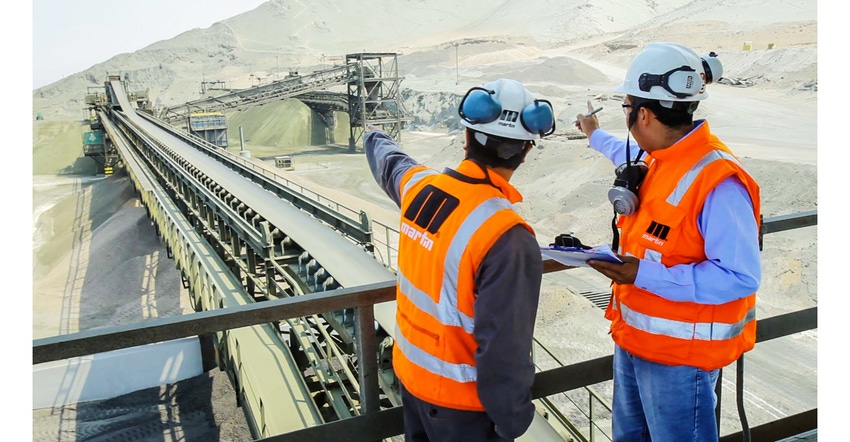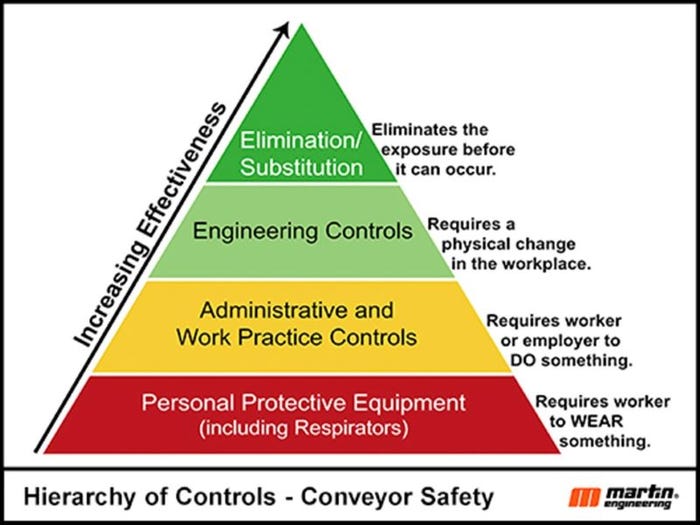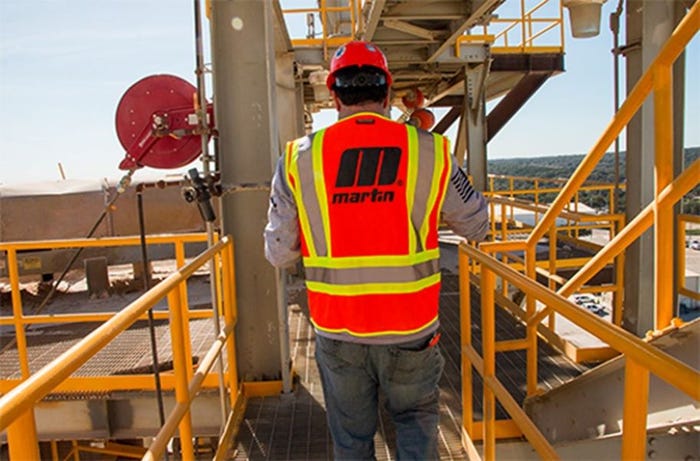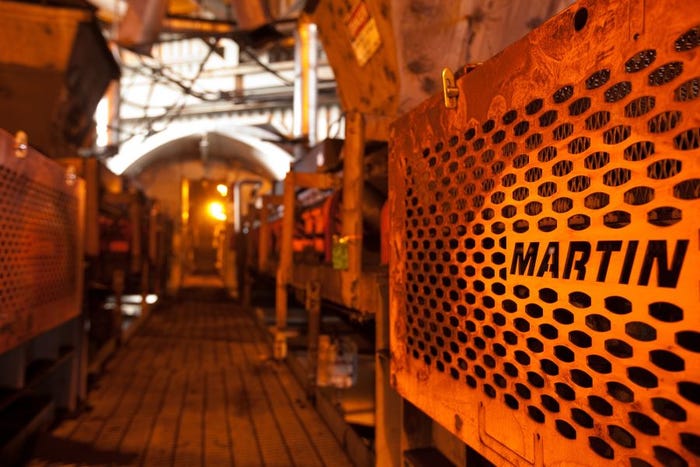Getting Measurable Results from Conveyor Training
Address fugitive material problems seriously and you will benefit from fewer safety incidents, less regulatory oversight, and higher productivity and profits.
October 11, 2023

R. Todd Swinderman, president emeritus at Martin Engineering
Are you just checking the boxes by doing required training hours, or is your goal to actually get a return on your investment? There can be huge improvements in production, maintenance labor, risk avoidance and cashflow by training employees on how to safely control fugitive materials in bulk material handling and then implementing changes. Unfortunately, half measures don’t get half results, so training alone won’t be sufficient. Following through on what has been learned is the key.
The motivation to take action developed in the classroom rarely turns into significant gains. After the training, prior habits often return with the symptoms of fugitive material being addressed but the root causes remaining untreated. Sometimes it’s a lack of funding or an understaffed maintenance department, or just a run-till-broke mentality. The pressure to get back into production overwhelms the logic of determining the root cause and taking the time to fix the problem correctly the first time. With this production-at-all-costs approach the problems never go away, and employees just have to accept the poor performance and added risks, which demoralizes them. Companies that place a priority on safety — and address fugitive material problems seriously — benefit from fewer safety incidents, less regulatory oversight, and higher productivity and profits.

Safety and Experience
Often management is hesitant to use outside contractors, reasoning that they have the skilled people on staff to do the work. At one location training and site surveys were done every 2 or 3 years by the same supplier. The site surveys show that nothing significant had changed and they just lived with the problems.
If the training was effective and there really is adequate maintenance staff, reports like this beg the questions, “Do you really have enough maintenance staff?” and “What did you get in return for the training, other than a certificate of completion?” Treating the symptoms often relies on time-worn design relationships or local experience, without a basic understanding of why the temporary fixes work or don’t work. Training should be robust enough to break the “We’ve always done it that way” mentality and encourage creativity in problem solving.
Unless those responsible for solving problems understand basic conveyor design, they may not grasp why old design rules or local solutions work to some extent on one conveyor but not on others. Unfortunately, some of these approaches find their way into corporate standards for conveyor design that only perpetuate the problems. Many times, the original conveyor design documents are lost or incomplete, so there’s no way to establish a baseline for remediation, which is a key for beginning root cause analysis and reducing the problems created by fugitive materials.
Too many owners consider conveying equipment to be a commodity to be purchased on price rather than on life-cycle cost, neglecting safety and productivity factors. The original conveyor design is critical to delivering the tonnage with a minimum of dust and spillage, but more importantly to the ability to solve problems that inevitably manifest themselves over the life of the conveyor. Just 10% more in up-front engineering focused on clean operation and efficient maintenance will pay a lifetime of dividends in productivity and safety.
Poorly designed transfer points and structural arrangements (or just plain drafted “same as before” designs) are the source of most fugitive material release, belt damage, and under-performing conveyors. Amazingly, conveyor upgrades frequently consist of simply increasing belt speed, which often results in lower output because the conveyor was not re-engineered to handle the extra tonnage. The material trajectory changes, causing more chute buildup and unplanned outages from plugged chutes, and the extra velocity and volume increase wear on components.
Most chute designs require confined space entry for cleaning and wear liner replacement, which could be greatly reduced by a maintenance-friendly design upfront. It’s almost inevitable that the conveyor capacity will need to be increased over the years, so why aren’t considerations for additional capacity considered in the original design? Buying on price from low bidders is often a root cause of designing yourself into a corner that can’t be designed around, so you just live with the problems.
Basic Training
Everyone operating, cleaning or maintaining conveyors should be trained in the hazards of belt conveyors and bulk material handling. Operators and cleaning crews should have a basic understanding of what is normal conveyor operation and what the common problems are, so they can be aware that there are ways to reduce day-to-day problems such as spillage and belt wander. Basic training includes topics such as guarding, identifying problems, and safe work practices. Appropriate safety training emphasizes how the belt can store elastic energy even when Lock-Out Tag-Out procedures are followed and why additional securing of the belt is required. Further, with the retirement of many experienced operators and mechanics — and the difficulty in finding new workers — it becomes critical that new employees understand the basics of conveyor design and operation.
Advanced Training
The engineering and maintenance staff should be additionally trained in fundamental conveyor design concepts, so they can analyze cause-and-effect relationships. Quite often the visible signs of poor conveyor operation are not the root cause of the problem. For example, using guide rollers to force the belt to track does not address the fundamental reason for the belt mistracking and usually results in belt edge damage. Some of the critical points that should be covered are designing the conveyor capacity to less than 100% to allow for surge loads and to reduce carry side spillage, structural and component alignment to the conveyor’s center line so the belt tracks true, adequate access and maintenance-friendly designs, transfer point design to control spillage and dust, and, importantly, how to justify improvements.
Sometimes training is on a specific piece of equipment with the goal of training the trainers so they can in turn educate the whole department. This approach works well with certain types of equipment such as mobile equipment or crushers, and you end up with one or two well-versed technicians who can troubleshoot and bring equipment back into specification. The tasks of cleaning up spillage and maintaining components that reduce fugitive materials release are not desirable careers. If a mechanic becomes proficient in troubleshooting and maintaining problem-solving components, they often move out of that position as soon as possible without passing on their knowledge to their replacement (if any).
A mechanic trained in installing problem solving components will run into a myriad of physical constraints. The original conveyor design and subsequent modifications can make it impossible to install equipment according to manufacturer’s instructions. Often structural obstructions or conveyor arrangements don’t allow enough room for installation, clear views for inspection or access for safe and easy maintenance access according to industry standards. Manufacturers’ installation instructions typically assume a wide-open space for installation without explanation of how to work around these issues. This leads to improperly installed, poorly performing equipment with no access for inspection and the likelihood of proper service near zero.
Conveyor design training for engineers and mechanics is critical so they can diagnose problems with an understanding of fundamental design methods. No two conveyors are identical and even twin conveyors side by side can act differently. Systems are often modified on the fly to try to minimize problems, and over time the conveyor is required to do things it was never designed to do. The Conveyor Equipment Manufacturers Association (CEMA) publishes a design guide, Belt Conveyors for Bulk Solids 7th edition, which includes both the calculation methods and generous discussions on the trade-offs designers must make to create a viable design.
Training for Results
Training alone rarely results in meaningful actions to improve conveyor performance. When management understands the clear links between safety, cleanliness, and productivity, it’s much easier to turn training into results. There are many variations of how this can work, but most success stories have common threads:
Basic training in conveyor hazards and the methods for controlling fugitive materials
Training in conveyor design fundamentals and the root causes of common problems
Management participation in the training to show support
A pilot program and measured results
A long-term plan implemented from a successful pilot program
Where to Start
A walkdown of one or two belts the day before the training and a review of goals helps the instructor focus on site-specific problems and management’s expectations. This survey and interview usually takes a few hours to half a day. The goal is for the instructor to have actual examples to show the class their problems are not necessarily unique. An experienced teacher will most likely have examples showing similar problems and their solutions.

The first day typically starts with reviewing the typical problems and getting the class to talk about their specific challenges. The class identifies a couple of problem conveyors and the class splits into small teams. Each team can look at the same problem or select different ones. Photos and videos of the issues are taken to be used in the problem-solving discussions. If only one instructor is available, the walkdowns may consume an entire afternoon, as it’s important to keep each team size small.
The rest of day one and the start of day two reviews basic design principles that relate to the problem conveyors. The discussion centers on possible root causes and solutions. Once the teams reach agreement on a way forward, they prepare a short presentation with the help of the instructor, using their actual conveyor problems and the knowledge they gained. The presentations may also include an estimate of the cost of the proposed solutions. The teams practice by presenting to each other and make any final adjustments to their presentations.
Management’s Role
At the end of day two, management is invited to listen to the team presentations and solutions. By participating in the class presentations, management shows a commitment to making improvements and has an opportunity to ask questions. The trainees, by making the presentations, show the knowledge they gained and support for the proposed solutions. The photos and videos can be used to create a PowerPoint presentation focusing on their site, and the inspection sheets help shed light on issues and solutions their crew experiences every day. At this step it’s critical that the manager(s) who attend the presentations have the authority to act on the proposals and, if so moved, commit to a pilot program to prove the imagined results can be turned into reality.
Pilot Program
One or more conveyors are selected for a trial program. While it’s normal to select the “worst” conveyor, keep in mind that half measures do not get half results, so you may be undertaking more than necessary to validate reductions in dust, spillage and mistracking. In many cases, e.g. too much tonnage being conveyed or no room for transfer point rebuild, the worst conveyor is not a candidate for significant improvement. Once a conveyor(s) has been selected, detailed proposals for retrofit can be obtained. An experienced person from the selected supplier must supervise the changes. Either outside contractors or in-house personnel can be used. It is important that sufficient downtime be allocated to properly modify the conveyor, because it may be months before the job can be completed piecemeal.
Measuring improvements is important but relatively easy to do. Photos and videos of before and after must be taken. Dust levels can be measured using instrumentation that can be provided by the equipment supplier or rented from a scientific equipment rental company. Most passive dust control methods focus on visible dust or nuisance particles, which are larger than respirable dust particles. Equipment should be selected based on the dust type to be measured and controlled. Spillage can be measured by placing buckets or trays in appropriate locations, while carryback can be measured by placing a tarp under several return idlers close to the discharge pulley. The collected fugitive materials are weighed for comparison after the conveyor has been modified. Dust and spillage sampling locations should be marked so the tests can be accurately repeated after retrofitting and an improvement percentage can be calculated.
The length of time for collecting samples can vary from a day to a week and should give a good representation of the average or typical operating environment and weather conditions. It is important to keep the dust monitor running even if the conveyor is running empty, as maximum fugitive dust levels are often detected when running conveyors empty long enough that the carryback dries out and becomes airborne.
Usually, the results of the pilot program are immediately noticeable, but without follow-up maintenance will deteriorate. There is a temptation to feel that the problem has been fixed and to revert back to delaying maintenance and then deal with the symptoms rather than root causes. Therefore, it’s important to agree upon a representative test period that lasts at least until the next downtime for maintenance and to include periodic inspections and adjustments by the equipment supplier.
Long-Term Results
One clean, safe conveyor can change long-standing opinions on how to control fugitive materials and improve safety. From a successful pilot program to a whole plant solution requires yet another deviation from common practice. The most effective approach is for single-source responsibility over a long period of time and agreements with outside conveyor maintenance contractors that both maintain and problem-solve. Typically, the contractor will use its own labor and equipment and work closely with the plant maintenance manager to maintain a level of acceptable performance. Alternately, a preferred contractor can be trained and supervised by the equipment supplier.
The outside contractor can even be responsible for cleanup, which adds an extra incentive to perform well. Acceptable performance can be measured in several ways.

Because the new norm will quickly become the accepted levels of cleanliness and conveyor operation, it’s human nature to conclude that the contractor is no longer needed. If this conclusion dominates and the maintenance contract is not renewed without a change in maintenance approach, the conveyors will revert to their old condition in a matter of months or a year at most. Two case studies are summarized to illustrate these points.
To demonstrate the benefit of safety to a company’s bottom line, OSHA created the online tool, ‘$afety Pays,’ which uses company-specific economic information to assess the potential economic impact of occupational injuries on that firm’s profitability. The program estimates direct costs (claim cost estimates provided by the National Council on Compensation Insurance) and indirect costs (provided by the Stanford University Department of Civil Engineering) and weighs them against financial details supplied by the company.
Underground Coal Mine
A US coal mine was having excessive safety incidents and very low availability. A pilot program was instituted to rework a transfer point to eliminate frequent cleaning due to belt stops, belt breaks and chute plugging. An outside contractor was hired for the work. To recruit and retain maintenance workers the contractor had developed a training program that included hands-on training on a full-sized conveyor coupled with classroom instruction. The benefit to the customer was having workers that are well trained in troubleshooting and the intricacies of installing problem-solving conveyor components.
Following a successful trial, an agreement for outside transfer point maintenance was reached covering 14 conveyors. The root causes of excess fugitive material were determined to be belt mistracking and conveyor overloading. Because there was so much unplanned downtime the conveyors would frequently be overloaded to try to catch up with production. With less cleanup and fewer belt repairs required safety incidents were dramatically reduced. A thorough analysis of this success can be found in the book, Foundations for Conveyor Safety.
The initial investment for equipment and installation was $350,000. The annual maintenance contract was for $100,000. The return on investment for the improvements in safety (often called soft or indirect costs) included a projected 10-year increase in cash flow (after the initial investment) of $643,000 — paid for the upgrades and maintenance contract. The increase in availability and increased production created significant additional direct cash generation. A full reading of this example, in Foundations for Conveyor Safety, shows that there can be multiple justifications for improvement and the value of specialty contracting.
Conclusion
The steel mine project illustrates the dramatic improvements that control of fugitive material can produce. The ability to add a third blast furnace without major changes in material handling is an excellent testimony that total control of a project can produce amazing results. Unfortunately, this point was reconfirmed when management ownership and philosophy changed, making the efforts to control fugitive material a low priority.
The coal mine project shows the drastic changes that can be made when management changes the culture and outside specialty maintenance is embraced. This coal mine had suffered through a major fatal incident that ultimately led to bankruptcy and new ownership. The new owner adopted a safety culture, embracing solving root causes, and the results speak for themselves. Training, when supported and implemented properly, can reduce the probability of an enterprise-wide disaster.
You May Also Like


